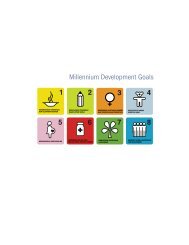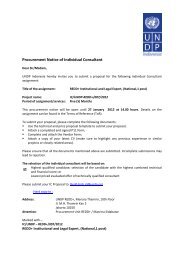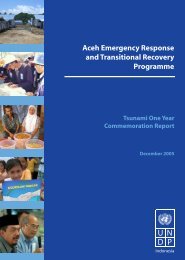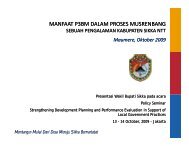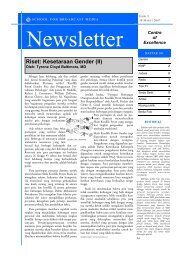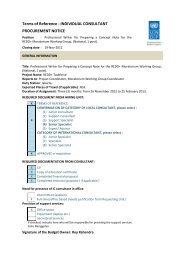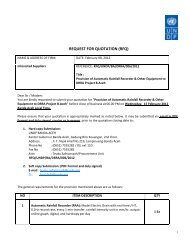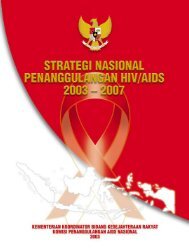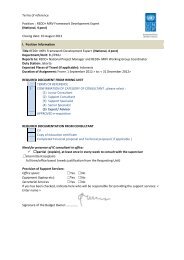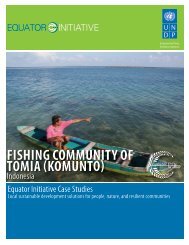English - UNDP
English - UNDP
English - UNDP
- No tags were found...
Create successful ePaper yourself
Turn your PDF publications into a flip-book with our unique Google optimized e-Paper software.
GOAL 1Eradicating ExtremePoverty and Hunger25
Indonesia Progress Report on the Millenium Development GoalsGoal 1: Eradicating ExtremePoverty And HungerTarget 1: Halve, between 1990 and 2015, the proportionof people whose income is less than one dollar a dayIndicators used:• Proportion of population below the national poverty line (poverty head count ratio)• Proportion of population below $1 per day• Poverty gap (incidence x depth of poverty)• Share of poorest quintile in national consumptionStatus and trendsPoverty head count ratio. The proportion of poorpopulation—those living below the national povertyline—decreased from 15.1 per cent in 1990 to 11.3per cent in 1996 (Figure 1.1). In 1998, the IndonesianGovernment adopted new thresholds for the nationalpoverty line that reflected a higher standard of living.Subsequently, 1996 poverty levels were adjustedto incorporate the 1998 criteria (Box 1). During theeconomic crisis, the proportion of poor populationincreased to 23.4 per cent in 1999 and then declinedto 18.2 per cent in 2002 and 17.4 per cent in 2003.Projections of trends between 1999 and 2003 showthat Indonesia is on track to achieving the MDG targeton poverty reduction of 7.5 per cent, or half the1990 levels for the country as a whole (Figure 1.2).However, prospects of achieving the MDG targetacross the provinces are uneven. (Table 1.1).Depth of poverty. The mean depth of poverty, b asa proportion of the poverty line, has varied from 10to 28 per cent since 1990. In 2002, the mean consumptionof the poor was 16.5 per cent below theNational Poverty Line (Table 1.2b)Figure 1.1. Population below the National Poverty LineFigure 1.2. Proportion of population below theNational Poverty LinePoverty gap. The poverty gap, or the Foster-Greer-Thorbeke P1 measure , has not shown much change,fluctuating between 2 and 4 per cent between 1990and 2002. In 2002, this measure a was 3 per cent (Figure1.4 and Table 1.2a).a The Poverty Gap is defined as Incidence times Depth of Poverty, also expressed aswhere n= population size; q= the number of poor people; z= poverty line; and yi = is the income of the individual=i.b The Depth of Poverty, I, is calculated as: ,where yp denotes the mean consumption of the poor.26
Indonesia Progress Report on the Millenium Development GoalsBox 1. The national poverty lineThe national poverty line is the rupiah value an individual needs to fulfil his or her daily minimum requirementfor food of 2,100 kilocalories (kcal), plus non-food minimum needs, such as housing, clothing, health,education and transportation. The food poverty line is the cost of meeting the basic food needs of 2,100kcal per day, while the non-food poverty line is how much a person has to spend to fulfil their basic, minimumnon-food requirements. People whose expenditures are less than the Poverty Line are classified asliving below the Poverty Line, or as poor population.The poverty standard used by the Central Statistical Office (BPS—Statistics Indonesia) is dynamic becauseit has to be realistic and adjust to shifts in consumption patterns and national aspirations. For example,Figure 1.1 shows two different estimates for the proportion of people living below the poverty line in 1996,based on two different criteria: the 1996 standard and 1998 standard. 1 The 1998 revision was done not onlybecause of the shift in consumption patterns but also because the definition of minimum basic requirementsand commodities had to be broadened to take into account new policies affecting family expenditure, suchas the introduction of nine years of compulsory basic education. The poverty data across years in Table 1.1are based on the two standards—1996 for the earlier years and 1998 for the later ones.Box 2. Assessing MDG achievementHow the MDG achievement is judgeddepends on which criteria are used.Applying the international criteria of$1 per day a , the proportion of poorpopulation in Indonesia in 1990 was20.6 per cent. In effect, this meansthat Indonesia had already achievedthe 2015 MDG target of 10.3 percent by 1996 and then again, followingthe economic crisis, by 2002.Figure 1.3. Proportion of population living below $1 and $2 per dayOn the other hand, using the $2a day criteria gives quite a different picture: poverty fell from 71 per cent to 54 per cent from 1990 to 2002,making the target for 2015 35.5 per cent. This means that Indonesia has been successful in eradicating extremepoverty, but still has some way to go in eradicating moderate poverty.a Standardized to 1993 international prices.27
Indonesia Progress Report on the Millenium Development GoalsFigure 1.4. Poverty gap, P1ChallengesFigure 1.5. Share of poorest quintile in national consumption%Disparities. The poverty-related challenges in Indonesiaare not only the large numbers of poor but alsothe striking disparities between regions, provinces,districts and cities. Jakarta and Papua illustrate thedisparity between provinces: in Jakarta, only 3.4 percent of the total population are poor, while abouthalf of Papua’s population lives below the povertyline (Table 1.1).Population at risk. A large proportion of vulnerablepeople is at risk of falling below the poverty linewith changes in their situation or policy directions.Since Indonesia has a significant share of populationwhose income or expenditure is just above the povertyline, a few percentage points’ rise in the povertyline leads to substantial increases in the number ofpoor people (Box 3).Share of poorest quintile in national consumption.This has remained at between 9 and 10 percent over the past decade (Figure 1.5 and Table1.3).Policies and programmesNational target and policies. According to the2000–2004 National Development Programme (Propenas),the national target on poverty eradicationBox 3. The impact of raising the poverty lineAreaPoverty line1996 criteria Criteria adjusted to 1998 standardPopulation belowpoverty linePoverty linePopulation belowpoverty lineRupiah per month Million per cent Rupiah per month Million per centUrban 38,246 7.2 9.7 42,032 9.6 13.6Rural 27,413 15.3 12.3 31,366 24.9 19.9Total 22.5 11.3 34.5 17.628
Indonesia Progress Report on the Millenium Development Goalsis to reduce the proportion of poor population to14 per cent by 2004. This target is to be achievedthrough two strategies: first, by raising income levelsthrough expanding employment and businessopportunities and increasing the productivity of thepoor; and second, by reducing the cost of food, education,health and infrastructure for poor families.The four main policies in reducing poverty focus onthe expansion of opportunities, empowerment ofcommunities, improvement of human resource capacities,and social protection.poor to conduct economic activities; and supplyingtransmigration settlements for landless farmers. Thethird programme will be implemented through developingculturally appropriate and effective socialsecurity systems; maintaining existing social securitysystems; and strengthening community and governmentcapacities in managing social security systems.All these poverty eradication programmes are comprehensiveand cross-sectoral in nature. There arealso other development programmes with activitiessupporting poverty reduction.Programmes. Poverty eradication is the main priorityin the Propenas. Based on Law No. 25/2000, povertyeradication is articulated by three programmes:equitable fulfilment of basic needs, such as essentialfood, basic health, education and housing servicesfor poor families and communities; the developmentof an entrepreneurial culture among the poorto enable them to be more productive economicallyand self-reliant; and the development of a social securitysystem to protect vulnerable groups, in particular,poor families, vulnerable children, the elderlyand the disabled.Activities. The first programme is implementedthrough providing essential food supplies; implementingprice controls; providing basic services,especially in health and education; expanding outreachservices; and improving the environment andhousing, including a clean water supply. The secondprogramme will be implemented through: providingeducation and training in entrepreneurial skills;providing technical assistance; promoting entrepreneurialnetworks and partnerships supported by localorganizations, local governments, the private sectorand universities; improving access to resources;providing infrastructure and facilities that enable the29
Indonesia Progress Report on the Millenium Development GoalsTarget 2: Halve, between 1990 and 2015, theproportion of people who suffer from hungerIndicators used:• Prevalence of underweight children under five years of age• Proportion of population below minimum level of dietary energy consumption (2,100 kcal percapita a day)Status and trendsFigure 1.7. Prevalence of underweight children under fiveyears of agePrevalence of underweight childrenTrends. Child malnutrition, as measured by theproportion of children under five years of age whoare moderately or severely underweight, decreasedfrom 37.5 per cent in 1989 to 24.6 per cent in 2000.However, a slight rise was seen between 2000 and2002, reaching 27.3 per cent in 2002. Over the sameperiod, severe malnutrition has increased slightly,from 6.3 per cent in 1989 to 8 per cent in 2002. Thesestatistics support the conclusion from Box 2 that Indonesiastill has some way to go before reaching thepoorest and most disadvantaged groups. It is alsonot on track in achieving the MDG target on malnutrition(Figures 1.6 and 1.7, Table 1.4).Figure 1.6. Prevalence of underweight childrenunder five years of ageDisparities. There has been a greater reduction innumbers of moderately and severely underweightchildren in rural areas than in urban centres. In bothareas, a consistently bigger proportion of male childrenare moderately or severely underweight thanfemale children across the years. The disparity in theproportions of underweight children between provincesis striking: from 17.1 per cent in Yogyakartaand 17.9 per cent in Bali to levels as high as 42.3 percent in Gorontalo and 38.6 per cent in East NusaTenggara (NTT) (Tables 1.4 and 1.5).Prevalence of under-nourishmentTrends. The proportion of people with insufficientfood is still high in Indonesia. Two-thirds of the populationstill consume less than 2,100 kcal a day. The30
Indonesia Progress Report on the Millenium Development Goalstrend has not changed much over the years (Figure1.8 and Table 1.6).Figure 1.8. Proportion of population below minimum level ofdietary energy consumption• Strengthening early warning systems for food andnutrition, so there will be preparedness for criticalperiods• Improving the quality of nutrition and food services,and integrating them into poverty-reductionprogrammes• Enforcing sanctions on violations of laws and regulationson food and nutrition, among them laws onfood fortification, advertising and labellingChallengesThe major challenges in reducing malnutrition andunder-nourishment will be ensuring that the poorpopulation, especially women and young children,have adequately nutritious food at an affordableprice, and reaching this population with interventionsfor nutrition education.Policies and programmesPolicy directions. Policies to address hunger arereflected by trends in community nutrition and thefood sector, where the focus is on developing andstrengthening food security systems based on adiversity of food sources, and on local institutions,cultures and coping mechanisms. The purpose is toensure the availability of food with adequate nutritionalquality at an affordable price.Food and nutrition policies. The priorities are:• Empowering families and communities—especiallypoor families and other vulnerable groups—to develop self-sufficiency in food through community-basedactivitiesProgrammes. These aim to address hunger andmalnutrition and improve household food security,and include:• Providing complementary feeding for infants andchildren under five years of age, and supplementaryfeeding for pregnant women from poor familiesor households lacking food security• Promoting and “socializing” 2 eating patterns thatare balanced and healthy• Producing and diversifying foods, including localand affordable alternatives• Educating families on nutrition and caring for children• Improving the efficiency of food distribution systemsto ensure household food security• Developing community self-sufficiency in food• Improving early warning systems for food securityto alleviate the impact of natural disasters andconflicts on vulnerable groups• Establishing supporting regulations for the Lawon Food (No. 7/1996) and implementing pro-poorregulations on food security and nutritionNotes1 BPS—Statistics Indonesia, 2003. Statistical Year Book ofIndonesia 2002.2 The terms “socialize” and “socialization” (sosialisasi), as used inIndonesia, mean: promoting an idea or programme, usually bydisseminating information or mobilizing communities.31
32Indonesia Progress Report on the Millenium Development Goals



